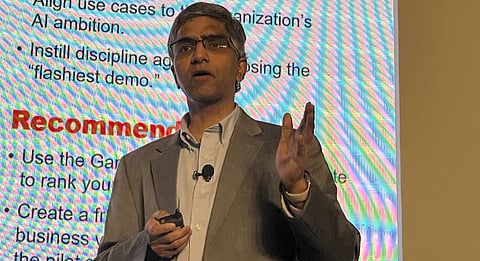Signature Series: Top Strategic Technology Trends for 2025 Outlook
Tech Trends 2025: Insights from Arun Chandrasekaran, Gartner’s Distinguished VP Analyst
In the ever-evolving world of technology, staying ahead of the curve is no longer optional—it’s a necessity. Arun Chandrasekaran, Distinguished VP Analyst at Gartner, recently unveiled the Top Strategic Technology Trends for 2025 in Gartner’s Signature Series. These trends are set to shape industries, redefine innovation, and create opportunities for organizations to thrive in a rapidly transforming world. Here’s a deep dive into what’s coming next.
AI Everywhere: The Era of Intelligent Everything
If 2023 and 2024 were the years of generative AI, 2025 will be the year AI becomes ubiquitous. Generative AI is no longer confined to creating art or text—it’s automating workflows, optimizing decisions, and driving innovation at scale.
But with great power comes great responsibility. Organizations are embracing AI Trust, Risk, and Security Management (TRiSM) to ensure their AI systems are ethical, explainable, and secure. As Arun Chandrasekaran explains, “AI is no longer just a tool; it’s the backbone of innovation. But trust in AI is as critical as its capabilities.”
Adaptive Autonomy: Systems That Think for Themselves
Machines are evolving from task-specific tools into adaptive systems that can respond to their environments. Autonomous systems, capable of self-optimization, will revolutionize industries from manufacturing to logistics.
These advancements are closely tied to the rise of digital twins, which are moving beyond simulations toward real-time, self-optimizing systems. Imagine a factory that not only identifies inefficiencies but also fixes them autonomously. That’s the power of adaptive autonomy.
Cloud-Native Platforms: Building for the Future
The shift to cloud-native platforms is redefining how businesses build and deploy applications. Gone are the days of monolithic systems. Instead, organizations are adopting composable architectures, where applications are modular and can be reassembled to meet changing needs.
Industry-specific clouds are also on the rise, offering tailored solutions for verticals like banking, healthcare, and manufacturing. These platforms are streamlining operations and driving innovation in ways we’ve never seen before.
Hyperautomation 2.0: The Next Frontier
Automation is growing up. While robotic process automation (RPA) has been a staple in recent years, Hyperautomation 2.0 takes things further by leveraging AI and machine learning to automate complex, end-to-end processes.
Organizations are also turning to process intelligence to identify automation opportunities and optimize workflows. As Chandrasekaran puts it, “Automation isn’t just about efficiency—it’s about transformation.”
Sustainable Tech: Innovation with a Conscience
Sustainability is no longer a side project; it’s a business imperative. In 2025, organizations will focus on green IT solutions that reduce energy consumption and promote a circular economy. Whether it’s through recycling, reusing, or refurbishing, sustainability is becoming a key driver of innovation.
Cybersecurity Mesh: A Decentralized Defense
As cyber threats grow more sophisticated, so must our defenses. The Cybersecurity Mesh Architecture (CSMA) is a decentralized approach that enables standalone security solutions to work together seamlessly.
With zero trust models evolving, organizations are also leveraging AI-driven behavioral analytics to enhance identity and access management. In the words of Chandrasekaran, “Security is no longer a perimeter—it’s a mesh.”
Superapps: The Swiss Army Knife of Digital Platforms
In 2025, superapps will become the go-to platforms for users, combining multiple app functionalities into a single, unified experience. Beyond convenience, these apps are expanding their ecosystems, integrating third-party services, and transforming how businesses engage with customers.
Next-Gen Networking: The Future is Connected
Connectivity is taking a quantum leap forward. From early 6G research to space-based networks, the next generation of connectivity solutions will bring ultra-low latency and global reach. This is particularly exciting for industries like healthcare, where real-time data transmission can save lives.
Augmented Workspaces: Redefining Collaboration
The workplace is undergoing a massive transformation, with tools like metaverse environments enabling immersive collaboration and training. Augmented reality (AR) wearables are also enhancing productivity, bridging the gap between the physical and digital worlds.
Digital Immune Systems: Resilience by Design
In 2025, businesses will prioritize digital immune systems—proactive measures designed to prevent disruptions and recover quickly. With advanced observability tools and analytics, organizations can identify and address potential failures before they occur.
What It All Means
The trends outlined by Arun Chandrasekaran paint a vivid picture of the future—one where technology is more integrated, adaptive, and sustainable than ever before. Organizations that embrace these trends will not only survive but thrive in an era of unprecedented change.
As Chandrasekaran aptly concludes, “The future belongs to those who are willing to innovate, adapt, and collaborate with technology. It’s not about keeping up—it’s about leading the way.”


